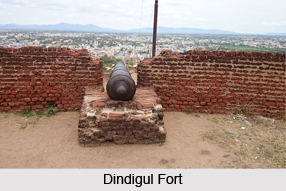 Dindigul Fort, also known as Dindigul Malai Kottai, is an ancient hill fort that was built in the 17th century the Dindigul town in the state of Tamil Nadu. It was constructed in 1605 by Muttu Krishnappa Nayaka of the Nayaka Dynasty of Madurai. In the early 18th century, the fortress was later occupied by the Wodeyars of the Kingdom of Mysore. Later during the reign of Hyder Ali and Tipu Sultan of Mysore, Dindigul Fort became one of the most prominent forts. Eventually during the Palayakarar Wars (Polygar Wars), the fort was seized by the British East India Company in 1799. The geographical coordinates of Dindigul Fort is latitude 10.35°N and longitude 77.95°E. The fort has height of nine hundred feet and is mostly created of granite. There is also a temple located in the vicinity of the fort. At present, it is held by the Archaeological Survey of India.
Dindigul Fort, also known as Dindigul Malai Kottai, is an ancient hill fort that was built in the 17th century the Dindigul town in the state of Tamil Nadu. It was constructed in 1605 by Muttu Krishnappa Nayaka of the Nayaka Dynasty of Madurai. In the early 18th century, the fortress was later occupied by the Wodeyars of the Kingdom of Mysore. Later during the reign of Hyder Ali and Tipu Sultan of Mysore, Dindigul Fort became one of the most prominent forts. Eventually during the Palayakarar Wars (Polygar Wars), the fort was seized by the British East India Company in 1799. The geographical coordinates of Dindigul Fort is latitude 10.35°N and longitude 77.95°E. The fort has height of nine hundred feet and is mostly created of granite. There is also a temple located in the vicinity of the fort. At present, it is held by the Archaeological Survey of India.
History of Dindigul Fort
Muttu Krishnappa Nayaka, a Nayaka ruler of Madurai, began constructing the rock fort in 1605. However the construction of Dindigul Fort was completed during the rule of Thirumalai Nayaka in 1655. An Abirami Amman Temple was also built in the vicinity. Later almost six hundred steps were carved in Dindigul Fort during the reign of Rani Mangamma of Madurai. These steps connected the rock fort with a hill temple. The fort was renovated to a great extent after Hyder Ali was appointed s the ruler of Mysore Kingdom in 1755. The ruler also made numerous additions to Dindigul Fort. The fort was strategically used by the Mysore kings during their military campaigns.
Hyder Ali of the Kingdom of Mysore constructed a mosque underneath Dindigul Fort particularly for his soldiers. The ancient fort was occupied by Tipu Sultan from 1784 till 1790. Syed Ibrahim, the Chief Commander of Tipu Sultan, fortified the walls of the fort, built many additional rooms and renovated a large part of the fortress. Dindigul Fort was strategically significant in numerous military conquests during the rule of the Nayak dynasty as well as Tipu Sultan of Mysore. It played an important role during the conflicts between the Nayaks of Madurai, the army of Mysore and the Marataha forces. It also served significantly during the battles between the Hyder Ali, Tipu Sultan and the British East India Company. After the defeat of Tipu Sultan in the Second Mysore War in 1790, the British East India Company seized the control of the fort.
Architecture of Dindigul Fort
Dindigul Fort has a circumference of almost 2.75 km and a height of 900 feet. Artillery and cannons were introduced during the 17th century. Thus double walls were built in the fortress in order to resist heavy artillery. The cannons were established at various vantage points across the fort and storehouse for arms and ammunition were also built with different safety measures. The double-walled godown room was well guarded against external danger and risk.
Moreover a thin brick wall was also built in one side of the storehouse through which the guards escaped during invasions and emergencies. The inclined ceiling of the storehouse prevented the leakage of rainwater. It has almost forty eight rooms that were initially utilized as prison cells to hold slaves and prisoners of war. The fort also included a horse stable, a huge kitchen and a conference hall for the commanders of the royal army of Hyder Ali and Tipu Sultan. Dindigul Fort also has reservoirs for storing rainwater. The architecture of the fort depicts the inventiveness of the rulers in the military and strategic designs of buildings.
Presently, Dindigul Fort is maintained by the Archaeological Survey of India and has been developed as a tourist destination.



















